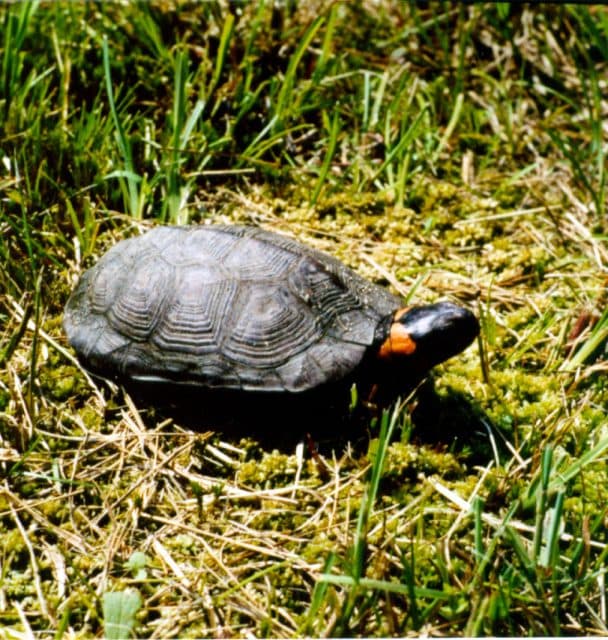| Place of Origin and Range |
The bog turtle is native only to the eastern United States. |
| Description |
The carapace is domed and rectangular in shape, and it tends to be narrower toward the head and wider toward the tail. The carapace often has easily identifiable rings on the rough scales or scutes. The scutes may also have a radiating arrangement of lines. In some older individuals, and those that burrow frequently in coarse substrates, the shell may be smooth. Although generally black, a chestnut sunburst pattern in each scute is sometimes present on the carapace. The belly of the shell, the plastron, is also a dark brown to black colour with light marks present. |
| Morph Patterns Available |
Yes |
| Adult Size |
Can grow up to 4 in (10 cm) |
| Accommodation |
They prefer calcareous wetlands (areas containing lime), including meadows, bogs, marshes, and spring seeps, that have both wet and dry regions. They require large enclosures, temperatures above 60 °F (16 °C), and bedding composed of grasses or grass-based hay. Due to their high dietary fibre needs, grasses form a minimum of 75% of their food intake. Including large amounts of clean, fresh water. |
| Lifespan |
Can live 20 - 30 years |
| Feeding / Diet |
Bog turtles are omnivorous and eat aquatic plants (such as duckweed), seeds, berries, earthworms, snails, slugs, insects, other invertebrates, frogs, and other small vertebrates. |
| Breeding |
The turtle has a low reproduction rate; females lay one clutch per year, with an average of three eggs each. The young tend to grow rapidly, reaching sexual maturity between the ages of 4 and 10 years old. |
| Other Considerations |
Considered threatened at the federal level, the bog turtle is protected under the United States' Endangered Species Act. Invasive plants and urban development have eradicated much of the bog turtle's habitat, substantially reducing its numbers. Watch for theses health concerns carefully with your turtle. Vitamin A Deficiency: Vitamin A is an important nutrient for your turtle’s health. It is found in his diet in the form of leafy green, orange or yellow vegetables, liver, and fish. If your turtle is not getting enough Vitamin A, he can suffer serious health problems. Always check to make sure that your turtle does not have swollen eyelids, as this is the main sign of a Vitamin A deficiency. Also, check for weight loss, nasal discharge and infected skin. Any of these symptoms could point to a deficiency. If you think your turtle may not be getting enough Vitamin A, you should take him to the veterinarian to get a firm diagnosis. Shell Problems: Your turtle’s shell is very important to his overall health. There are many potential problems that could occur, so you should be on the lookout at all times. Respiratory Disease: Respiratory infections have symptoms similar to vitamin A deficiency, including swollen eyelids and runny nose, so you should take your turtle to the veterinarian to get a proper diagnosis if you suspect either. More serious infections will be characterized by breathing through the mouth, mucus in the mouth, and wheezing. Always make sure your turtle’s environment has the proper amount of humidity, as this will help prevent respiratory problems. |




